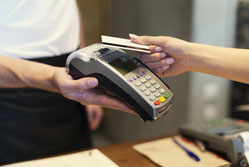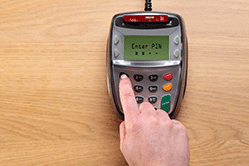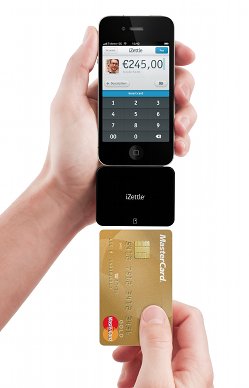Blog posts tagged payment
Do you understand contactless payments?
 The ways we pay are changing fast. No matter what sort of business you run, customers will expect to be able to pay by their preferred method.
The ways we pay are changing fast. No matter what sort of business you run, customers will expect to be able to pay by their preferred method.
If you only accept a limited number of payment methods, people may be put off buying from you. With that in mind, perhaps you should be thinking about contactless payment, because this is one option that has really taken off in the last 12 months.
Contactless growth
Contactless payments are growing fast. Monthly spending on contactless cards exceeded £100m for the first time in March 2014, according to the UK Cards Association.
More than 370 contactless transactions are made every minute in the UK. That’s six per second — three times more than a year ago.
Although contactless is seen as a new technology, it’s actually been around since 2008. The same technology powers Transport for London’s Oyster card system, where passengers pay for public transport journeys via contactless cards pre-loaded with credit.
How contactless works
Contactless cards use a short-range wireless system called near field communications (NFC).
Contactless debit and credit cards are fitted with an antenna that connects them with devices up to 5cm away. When the cardholder passes their card close to a contactless payment machine, their payment is registered.
Because it’s so easy to make a payment, the contactless system has been designed to minimise the chance of duplicate or accidental transactions.
The terminals make sure only one payment is taken per transaction. To make a second payment, the card has to be taken out of range of the card reader, and then reintroduced.
Even then, a second payment will only be taken if the sales assistant has initiated a new transaction.
Software in the cash register or point of sale terminal also checks if there’s more than one card within range. It will reject the transaction if there’s a risk of the wrong card being charged.
The contactless advantage
‘Tap and go’ contactless transactions take less than a second, making shopping quicker and easier. If you run a shop, this reduces queues, makes customers happier and gives you more time to engage with them.
Major high street names such as Marks & Spencer, Costa and Boots are all using contactless. Although uptake among smaller businesses is harder to measure, it seems widespread.
There’ll already be at least one business on your local High Street that accepts contactless payments. More are joining every day.
This post is by Andy Macauley, chief operating officer at Handepay, which offers a free guide to contactless payments.
Which card payment terminal is right for you?
 If you want to start accepting card payments, there’s a wide range of card payment machines to choose from. With so many options available, it can be hard to know where to start.
If you want to start accepting card payments, there’s a wide range of card payment machines to choose from. With so many options available, it can be hard to know where to start.
The first thing to do is consider your business and your customers. What do you sell? Are you always at a desk or are your customers spread out? How do you carry out most transactions: face to face, over the phone, online?
Once you answer these three questions, the type of card payment terminal you need should become clear. There are three basic types:
- Countertop card payment terminals. These operate from a fixed location. They can operate via dial-up (using your phone line) or over your existing broadband connection, and fit on to most shop counters.
- Mobile card payment terminals. These have a SIM card like a mobile phone and are used mainly by delivery services, market traders and other businesses on the go — anywhere where there isn’t a fixed point of sale or broadband connection.
You need a mobile phone signal to use a mobile card payment terminal. Some of use an app on a smart phone along with a Bluetooth connected chip and pin keypad. - Portable card payment terminals. These are popular with hotels, restaurants, bars, hairdressers, coffee shops and in other situations where the customer is not always in the same spot.
The terminal will operate within a certain radius of its base unit, which connects to your phone line or broadband like a countertop terminal.
One other thing to consider is whether you’d like to have the ability to take contactless payments, where customers can pay smaller amounts by waving their card over a card reader, instead of having to input a PIN.
To encourage use of contactless payments, some payment providers are offering lower commission rates on debit card payments, so if this appeals to you and your customers, it could be worth your while.
All types of card payment terminals are available with contactless functionality.
Andy Macauley is chief operating officer of Handepay.
An easier way to take credit cards?
 Small retailers have long known that if you want to be able to accept credit cards, you need to be good at jumping through hoops. Applying for and getting set up with a merchant account can be a lengthy process.
Small retailers have long known that if you want to be able to accept credit cards, you need to be good at jumping through hoops. Applying for and getting set up with a merchant account can be a lengthy process.
Things could be changing though, if a company called iZettle has its way. This Swedish firm is currently trialling a UK service that enables you to process credit card payments through your mobile phone.
How iZettle works
When you sign up to iZettle, you get a card reader that attaches to your iPhone or iPad (see image - it's not available for other types of mobile at the moment) and an app that runs on your phone. Together, these turn your phone into a credit card terminal.
You open the app, tap in the amount to be paid, push your customer's card into the card reader, then pass the handset to them to sign on the screen. iZettle claims to work wherever you are, as long as there's an internet connection over which it can authorise the card.
The costs look reasonable too - there's a commission of about 3% on each payment, there aren't any subscription fees, and even the card reader is free.
You could use iZettle wherever you want. It would be useful for retailers, restaurants and bars, but because it runs on your mobile phone it also appears to be good for people who work on the move - like taxi drivers - or for use at events like trade shows.
No Visa, no PIN
Before you get too excited, iZettle has some disadvantages. It currently works only with MasterCard, American Express and Diners Club cards, leaving a pretty big Visa shaped hole in things.
It also seems to rely on a customer signature rather than using chip and PIN to process payments. Given the publicity-heavy switch to chip and PIN in 2005, it might unnerve your customers to find themselves having to sign again.
The first of many?
Despite these limitations, iZettle could be an early warning of what's on the horizon.
Our sister site Marketing Donut mentioned US company Square back in 2009. Since then, this similar service has grown to process $4bn worth of payments a year. PayPal is also introducing a mobile card payment service in the US.
Closer to home, mPowa and SysPay are both available or coming soon in the UK. And expect to see other companies announce similar services in the next few months.
Even if you already have a merchant account, these new players could shake up the market, potentially driving down costs and forcing established competitors to up their games. Good news, surely?
- How to accept payments on your website
- Contactless payments infographic
- Trends that could influence your IT strategy



